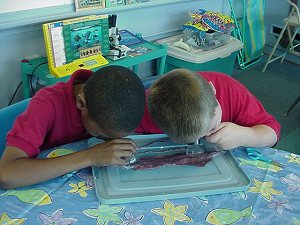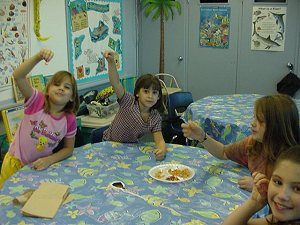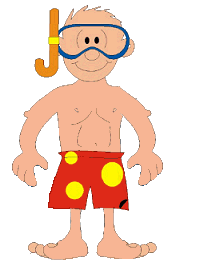|
Background:
Mollusks
are soft bodied animals. They are invertebrates which means that
they don't have a backbone. The largest three categories of mollusks are:
univalves - animals with one
shell such as a conch, oyster drill, and abalone
bivalves - animals with two
shells such as clams, oysters, and scallops
cephalopods - soft bodied
animals with no shell such as octopus, squid, and cuttlefish. The word
cephalopod means "head foot." Giant
squid are the largest cephalopod (octopus, cuttlefish, squid) and the
largest mollusk. The largest recorded giant squid was 59 feet
long. The average size of the giant squid is 20 to 43 feet long and
between 110 and 660 pounds. The octopus and squid are considered to be the
most intelligent of all invertebrates. They have well developed eyes
and brains. Their eyes are similar to human eyes.

Activities:
 Bring in boxes of shells which
students classify into two
groups: bivalves and univalves. Try to have an abalone shell because the kids always have a discussion as to how to classify it. Bring in boxes of shells which
students classify into two
groups: bivalves and univalves. Try to have an abalone shell because the kids always have a discussion as to how to classify it. |
 |
|

|
 Use two salad size paper plates to make a model of a clam. The students
draw the organs on the inside of one of the plates and color the other light
pink on the inside. Color the plates to look like a shell on the
outside. Then staple the two plates together to make a model of a bivalve.
For fun, you can get fake pearl beads and place inside the shell if the students
make oysters. Use two salad size paper plates to make a model of a clam. The students
draw the organs on the inside of one of the plates and color the other light
pink on the inside. Color the plates to look like a shell on the
outside. Then staple the two plates together to make a model of a bivalve.
For fun, you can get fake pearl beads and place inside the shell if the students
make oysters.
|
 To
introduce the class of cephalopods, go to
the seafood market and buy fresh squid to dissect. The kids love to
use the pen to write messages to their friends with the ink of the squid.
You can also buy a frozen octopus to show the students. Do a demonstration
dissection of the octopus rather than have students individually dissect. Click
here to get the squid dissection guide. To
introduce the class of cephalopods, go to
the seafood market and buy fresh squid to dissect. The kids love to
use the pen to write messages to their friends with the ink of the squid.
You can also buy a frozen octopus to show the students. Do a demonstration
dissection of the octopus rather than have students individually dissect. Click
here to get the squid dissection guide. |
 |
 |
 With the
squid you do not dissect, you can cook calamari. Peel the skin from the
quid. Open the squid and remove the internal organs, cut it into small
strips or rings, wash
it thoroughly, and coat it with seafood batter mix. Put it into a
deep fryer such as a "Fry Daddy" and cook it until golden brown. Serve it with
cocktail sauce. Usually even the faint hearted will take a bite.
Most students love it! With the
squid you do not dissect, you can cook calamari. Peel the skin from the
quid. Open the squid and remove the internal organs, cut it into small
strips or rings, wash
it thoroughly, and coat it with seafood batter mix. Put it into a
deep fryer such as a "Fry Daddy" and cook it until golden brown. Serve it with
cocktail sauce. Usually even the faint hearted will take a bite.
Most students love it!
|
 A Delicious Octopus Treat: Give
each student 2 round butter crackers, 2 mini M&M's, 8 licorice strips, a
plastic knife, and about a tablespoon of peanut butter. Have the
children spread the peanut butter on one of the crackers. Press 8 strips
of licorice onto the peanut butter for legs. Put the second cracker on top
and spread it with peanut butter. Add the mini M&M's for eyes.
Enjoy! A Delicious Octopus Treat: Give
each student 2 round butter crackers, 2 mini M&M's, 8 licorice strips, a
plastic knife, and about a tablespoon of peanut butter. Have the
children spread the peanut butter on one of the crackers. Press 8 strips
of licorice onto the peanut butter for legs. Put the second cracker on top
and spread it with peanut butter. Add the mini M&M's for eyes.
Enjoy!
 Hot dog octopus - cut 8 strips into a hot dog about 3/4 the length of the
hot dog. Put the hot dog in boiling water. The "arms" of
the octopus will curl. Eat and enjoy!
Hot dog octopus - cut 8 strips into a hot dog about 3/4 the length of the
hot dog. Put the hot dog in boiling water. The "arms" of
the octopus will curl. Eat and enjoy!
 Make a stuffed octopus out of a pair of knee high panty hose. Stuff
the toe end to make the head. Tie under the head with a piece of
yarn. Cut the remaining part of the hose into eight strips.
Glue cheerios onto the strips to make the suckers of the arms of the
octopus. Glue wiggly eyes on the head.
Make a stuffed octopus out of a pair of knee high panty hose. Stuff
the toe end to make the head. Tie under the head with a piece of
yarn. Cut the remaining part of the hose into eight strips.
Glue cheerios onto the strips to make the suckers of the arms of the
octopus. Glue wiggly eyes on the head.
 Have an eight-legged octopus race - Have four students stand back to back
and link arms to make an eight legged octopus. Have each
"octopus" race other "octopuses" to see who is the
fastest "octopus."
Have an eight-legged octopus race - Have four students stand back to back
and link arms to make an eight legged octopus. Have each
"octopus" race other "octopuses" to see who is the
fastest "octopus."
 Clam
Dissection Activity Clam
Dissection Activity
 Make
a Seashell Soap Dish Make
a Seashell Soap Dish
Back
to Under the Sea ~ Fishy
Links - Ocean
Life Links ~ Teacher's Guide
Fishy
Tales - Student
Storybooks for Under the Sea
~ Fishy Fun
|






![]()
![]()

![]()

![]()

